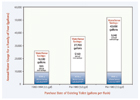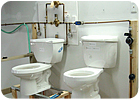
No matter whom you talk to, everyone has the same expectation: Clean and plentiful water supplies on demand. Thanks to decades of sound planning and engineering, the plumbing industry has generally met the demand and delivered with a combination of top-quality products and plumbing expertise throughout the supply chain.
But water supplies are getting tighter. Both the demand for water and costs to deliver water continue to rise. Moving forward, whether you manufacture, design, install, maintain or repair plumbing systems, your customers are going to start demanding the same or higher levels of performance from more water-efficient products and systems.
With the ultimate goal of saving water resources for future generations, the U.S. Environmental Protection Agency (EPA) has launched a new partnership program: WaterSense. Everyone plays a role in this public-private partnership-manufacturers develop and market high-efficiency products, utilities promote the use of these products through rebates and other programs, and retailers and distributors sell them to homeowners, businesses and service providers. Plumbing engineers can get involved by specifying and designing for high-efficiency products in their projects.
A key component of the program is the WaterSense label. The label differentiates products that meet the program’s water efficiency and performance criteria and helps consumers readily identify water-efficient products. To label a product, manufacturers must have it certified by an independent third party as meeting WaterSense performance standards. With WaterSense, individual plumbing products will, for the first time, bear a label that denotes water efficiency, which will allow manufacturers to highlight their products’ performance and environmental benefits.
The WaterSense label also will create consumer confidence in new, high-efficiency products. Because meeting rigorous technical requirements is part of the labeling process, consumers will come to recognize the label as an indicator of not only water efficiency, but also high performance.
Flush With Possibilities
Imagine being able to quickly and easily identify high-performing, water-efficient toilets in plumbing catalogues, on Web sites and in stores. Earlier this year, EPA finalized its first product specification for tank-type high-efficiency toilets. As a result, this summer, millions of Americans will be able to select a WaterSense-labeled high-efficiency toilet (HET).
At the time of the release of the WaterSense tank-type HET Specification, the Uniform North American Requirements (UNAR) waste removal requirement was 250 grams of media. It has since been revised to also require the removal of a minimum of 350 grams of media.
The WaterSense HET specification addresses toilets typically found in homes and light commercial settings such as hotels and restaurants, including gravity-type, pressure-assisted and electrohydraulic-assisted toilets. It does not address flushometer valve-type toilets typically found in commercial, institutional and industrial settings (e.g., airports, arenas, schools, office buildings) or composting toilets because of their different designs, patterns of use and performance requirements. WaterSense is examining these technologies, however, and may address these products in separate specifications in the future.
WaterSense developed the tank-type HET specification through a process of significant stakeholder input, market research and technical review. EPA’s efficiency and performance criteria are based on the specification from the existing Uniform North American Requirements (UNAR) for Toilet Fixtures: Guidelines and Specifications, which were established by water utility representatives and members of the plumbing industry to create a uniform set of standards.

Figure
1. Potential water and cost savings for
a family of four replacing an older toilet with a WaterSense-labeled
high-efficiency toilet (HET).
The MaP test establishes performance testing requirements, and LADWP SPS requires the use of durable, chemical-resistant flush valve seals and restricts maximum flush volumes under maximum trim adjustments and pressure conditions.
In order to receive the WaterSense label for a tank-type HET, EPA’s specification requires:
• A toilet’s effective flush volume to be less than 1.28 gallons per flush (gpf); this represents a 20% increase in efficiency over the current 1.6-gpf standard mandated by the Energy Policy Act of 1992 (EPAct 1992).
• Complete removal of 350 grams of waste media plus four balls of loosely crumpled toilet paper on 4 out of 5 attempts.
• The use of a pilot valve, or another type of fill valve, that complies with a fill valve integrity test protocol.
• Any barrier, bucket, dam or displacement device used in the toilet tank to be permanent and tamper-resistant.
• When the tank trim is set to its maximum setting and the water supply static pressure is increased to 80 pounds per square inch (psi), that the flush volume not increase by more than 0.4 gpf for single-flush toilets (i.e., 1.68 gpf/6.4 Liters per flush [Lpf]) and the full-flush mode in dual-flush toilets (i.e., 2.0 gpf/7.6 Lpf). The reduced-flush mode flush volume cannot increase by more than 0.3 gpf (i.e., no more than 1.4 gpf/5.3 Lpf).
• The testing of replacement flush valve seals to ensure that replacing manufacturer-installed seals with off-the-shelf replacements will not increase the toilet’s flush volume.
Both single-flush and dual-flush HETs are eligible for the WaterSense label. Single-flush toilets must use 1.28 gpf or less per flush. For dual-flush toilets, the effective flush volume, determined by taking the average of one full flush and two reduced flushes, must be 1.28 gpf or less. This means a dual-flush toilet that uses 1.6 gpf of less for its full flush and 1.1 gpf or less for its reduced flush would qualify.
To ensure a higher level of performance, the WaterSense specification requires toilets to flush 350 grams of media at 1.28 gpf-a more rigorous criterion than UNAR’s minimum requirement of removing 250 grams of media with a maximum of 1.6 gpf. One reason for increasing the waste removal requirement was to avoid user satisfaction problems that arose in the 1990s, when some of the new 1.6-gpf ultra-low-flush toilets introduced to meet the EPAct 1992 requirements did not perform to users’ satisfaction.
Although many design problems have been corrected, and toilets made today perform much better than some initial models, these original poorly performing products created a stigma among “low-flow” toilets that still lingers to this day. EPA hopes to overcome this consumer perception by broadly promoting the performance requirements of WaterSense-labeled HETs, including the independent certification that manufacturers must complete before their products can bear the label.
The WaterSense specification further diverges from the UNAR specification by requiring the use of an uncased soybean paste media in the performance testing. The decision to revert to the use of uncased media was driven by concerns raised by a few manufacturers over the variability in test results when using the cased tubular media during in-house product testing. Uncased media had been used for several years prior to the introduction of the cased samples, and has a well-established testing track record. Cased media was first introduced in response to manufacturers’ complaints about the cost of performing multiple tests, each of which required a new set of test media. Since the WaterSense specification only requires a maximum of five tests per HET, the cost issue became irrelevant. Many stakeholders also commented that the uncased media provides a more realistic sample than the cased media.

A
maximum performance (MaP) testing rig. Photo courtesy of John Koeller, Koeller
and Co.
To further address this issue, WaterSense sponsored a subsequent study that tested under more-difficult-than-average conditions, consisting of a four-inch diameter drainpipe installed at a 1% slope. Even under these adverse conditions, all HETs tested (even 1-gallon models) exceeded the targeted 4-meter (12.2 feet) drainline carry distance. Based upon these studies, WaterSense feels confident that HETs flushing with as little as one gallon provide sufficient water in residential and commercial applications to move the waste from the fixtures to the sewer.
As shown inFigure 1), an average family of four replacing its inefficient 3.5-gpf toilet with a 1.28-gpf, WaterSense-labeled HET could reduce its water consumption by as much as 16,500 gallons each year, and reduce its annual water costs by $95. At the national level, replacing just 10% of the existing less-efficient toilet stock could save 246 million gallons of water a day and 89.7 billion gallons of water each year.
While manufacturers are currently in the process of applying to use the label on products, EPA does not anticipate a problem with consumers finding WaterSense-labeled HETs in the future; there are currently a dozen manufacturers producing more than 60 models that could potentially meet the WaterSense specification requirements.
References
Bill Gauley, Veritec Consulting, Inc. and John Koeller, Koeller and Co. “Evaluation of Water-Efficient Toilet Technologies to Carry Waste in Drainlines: A Canada Mortgage and Housing Corporation Project: Final Report” (Revision #1 – April 1, 2005) and “WaterSense Drainline Carry Testing Results” (Nov. 2006).
Sidebar: Certified for Conformance
For a manufacturer to use the WaterSense label on a product, the product must be certified to meet the WaterSense specification criteria. Only an independent, third-party product certification body that has been approved by EPA can determine whether a product meets the WaterSense specification.As part of the certification process, EPA licenses product certification bodies to sample and test products, issue manufacturers the WaterSense label, and provide ongoing product surveillance. This surveillance may include:
• Facility inspections to assess mass production capability and quality management systems;
• Periodic product retesting to WaterSense criteria; and
• Warehouse/home center inspections to make sure the label is being used properly.
WaterSense has approved five independent certification bodies to certify products to the WaterSense tank-type HET specification. Manufacturers seeking the WaterSense label may apply directly to any of the following approved product certification bodies: CSA Intl., IAPMO R&T, Intertek, NSF Intl. and Underwriters Laboratories USA.
When specifying a WaterSense-labeled HET, look for the certification body’s name below the label to ensure that the product has been certified to meet the WaterSense efficiency and performance criteria.